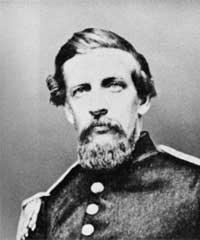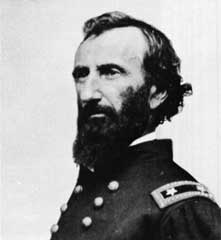|
VICKSBURG National Military Park |
 |
 Maj. Gen. John S. Bowen, commanding the Confederate troops at the battle of Port Gibson. Courtesy Confederate Museum, Richmond. |
 Maj. Gen. John A. McClernand, commanding the Union XIII Corps. Courtesy National Archives. |
The Siege of Vicksburg (continued)
JOHNSTON'S DILEMMA. Pemberton's foremost objective in prolonging the siege had been to afford Johnston and the Confederate government time to collect sufficient troops to raise the siege. But shortly after Grant had invested the city, Gen. Robert E. Lee's Army of Northern Virginia began its invasion of the North, which ended on the field of Gettysburg. No troops could be spared from that point. To have removed troops from Lt. Gen. Braxton Bragg's army in Tennessee would have dangerously weakened that place in a desperate attempt to save the Mississippi. Johnston wired Secretary of War James A. Seddon "We cannot hold both."
During June, General Johnston had succeeded in increasing his force to about 30,000, many of whom were green troops, but efforts to secure adequate weapons, ammunition and wagons to equip the regiments had been only partly successful. Preparing to encounter an expected move by Johnston against his rear, Grant used reinforcements arriving from Memphis to construct and man a strong outer defense line facing Johnston's line of advance. Grant then had two lines of works, one to hold Pemberton in, the other to hold Johnston out. While Seddon notified Johnston "Rely upon it, the eyes and hopes of the whole Confederacy are upon you, with the full confidence that you will act, and with the sentiment that it is better to fail nobly daring, than, through prudence even, to be inactive," Johnston notified his government on June 15 "I consider saving Vicksburg hopeless."
On July 1, Johnston moved his army of 4 infantry and 1 cavalry divisions to the east bank of the Big Black River, seeking a vulnerable place to attack Grant's outer defenses. His reconnaissance during the next 3 days convinced him that no move against the Federal position was practicable. Receiving word of the surrender on July 4, he with drew to Jackson.

|

| History | Links to the Past | National Park Service | Search | Contact |
|
Last Modified: Mon, Dec 2 2002 10:00:00 am PDT |

